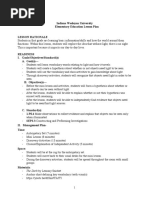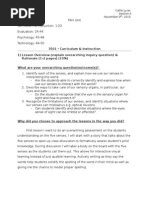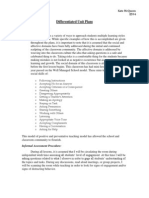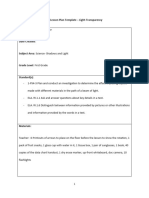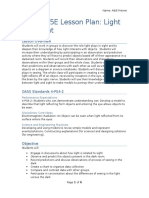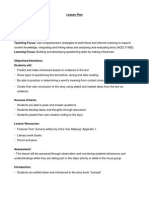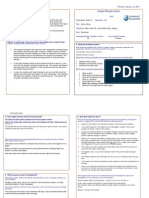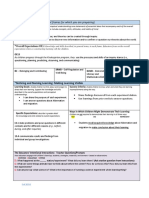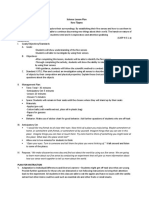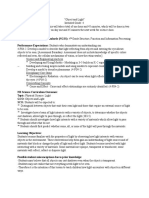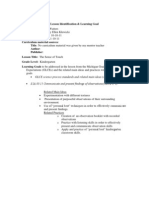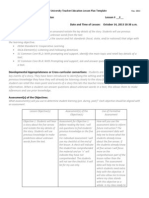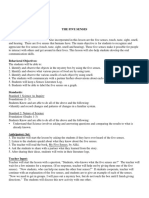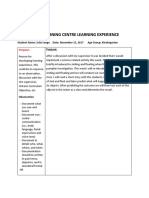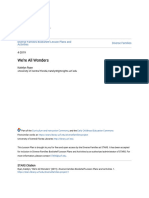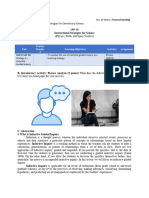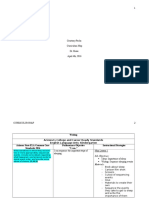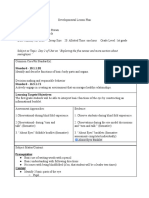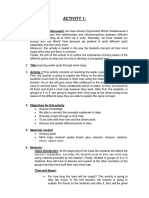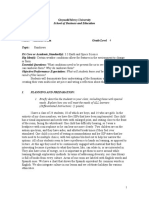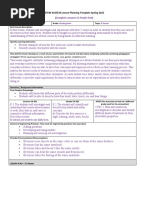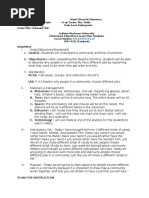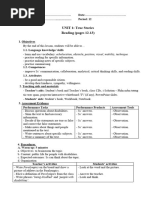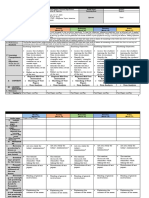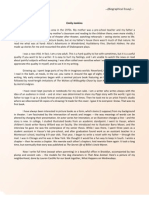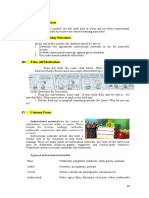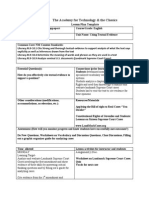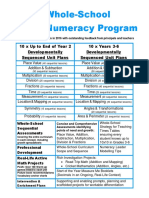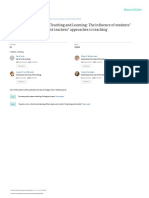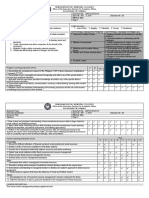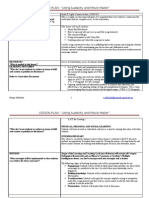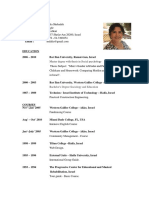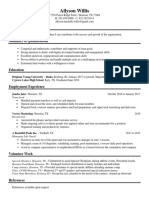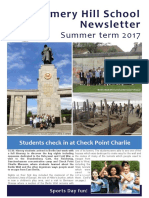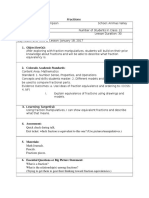Sense of Sight
Sense of Sight
Uploaded by
kels_006Copyright:
Available Formats
Sense of Sight
Sense of Sight
Uploaded by
kels_006Copyright
Available Formats
Share this document
Did you find this document useful?
Is this content inappropriate?
Copyright:
Available Formats
Sense of Sight
Sense of Sight
Uploaded by
kels_006Copyright:
Available Formats
Lesson
#2 Sense of Sight (30 minutes)
Grade Level:
Subject:
Science
Prepared By: Kelsey Graff
Date:
Overview & Purpose: 1. The students will be introduced to the sense of sight through discovery. 2. The students will learn about the different parts of the eye. 3. The students will learn that you need light in order for your sense of sight to work. PGG goal(s) addressed: 6.4 Plans and develops engaging and authentic lessons that demonstrate knowledge and confidence in subject matter: This lesson is fully engaging the students by allowing them to discover their sense of sight. It is a hands-on experience with the subject matter. 1.3 - Uses constructivist principles to guide student learning: I am building upon the students experiences with their eyes. Teacher SE1.1 Investigate characteristics of the five senses in humans and other animals. SE1.2 Explore how humans and animals use their senses to interact with their environment.
Broad Areas of Learning: Cross Curricular Competencies: - Developing Thinking: Students are asked to inquire about what is being presented to them.
Outcome:
Students Indicator: a. Identify each of the senses and associate those senses with parts of humans or animals. b. Identify characteristics used to describe the range of observations related to each sense. c. Pose questions that lead to exploration and investigation of senses in humans. 1. The students will go to the gym to take part in the activity. Materials Needed: - My Five Senses Booklets
Procedures: 1. Motivational Set: Take the students into the gym and shut off the lights. - Make sure that it is very dark so that the students cannot see what
you are holding (warn the students before darkening the room so that they do not get scared). 2. Show the students pictures in the dark. - I am holding a picture in my hand, what is it a picture of? - What do you mean you cannot see it? Its right here! 3. Bring out a flashlight and hold it up to the picture. - Can you tell me what the picture is now? - Then bring out a lamp and hold it up to the picture. - Bring out a candle. - Bring out a lantern. - What does all of this tell us about our sense of sight? - What do our eyes need in order to see? - Our eyes are very important because they give us lots of information about our surroundings. For example: street lights/signs, reading, labels (poisons), etc 4. Talk about pupils. Tell them that our eyes have pupils, which get bigger in the dark to let more light in, and smaller in the light to let less light in. - Turn the lights back on. Ask the 2. The students will realize that they cannot see the picture in the dark. They may say that they need some light to see the picture. - Pictures of different things.
3. The students will discover that their eyes need light in order to see. There are many types of light sources that allow our eyes to see.
Flashlight Lamp Candle Lighter Lantern
4. The students will discuss why they think their eyes hurt when they turn on a bright light after being in the dark.
student why they think it hurts your eyes when you turn on a bright light after being in the dark. - It is because our pupils got bigger in the dark, and when you suddenly turn the lights back on it takes time for them to get small again and they are letting in too much light. 5. Read the students a story about our sense of sight called Seeing. (If there is no time for the story it can be read at another time during the day) 6. Go over eye diagram to show the different parts of the eye. Have the students echo each different part. Then have them try it on their own. 7. The students can start working on the second page of their My Five Senses booklet. - Today we are going to do the second page of our booklets where it says Sight. - Read over what it says and give examples of what you like to see. 5. The students will listen to the story and answer the questions posed to them. Gordon, Sharon. (2001). Seeing. New York: Childrens Press Inc.
6. The students will echo each part of the eye after I have gone over them and then try saying each part on their own. 7. The students will draw and then color in their booklets.
- Eye diagram
- My Five Senses Booklet
Accommodations/Modifications
None
None
Assessment (Steps to check for student understanding must assess outcomes.) -
I will listen to the students answers to the questions posed to find out what they already know about their sense of sight.
The students should give meaningful thought to the questions posed to them.
Other Resources
Closure (Reinforce the lesson)
Quickly review: What sense were we using today in order for us to see the pictures I was holding up? What did we need in order for our eyes to see what I was holding up? What different types of light sources did I use?
- The students will answer the questions posed to them.
Reflections (What went well; what could be improved)
- The students got a lot out of this lesson. None of them had ever heard of what their pupils were and were fascinated by the fact that they changed in size. They were also very engaged with what I was doing in the gym with all of the different light sources.
Additional Notes
You might also like
- Backwards Design FinalDocument12 pagesBackwards Design Finalapi-253513324No ratings yet
- Lac On Learning Delivery Modalities Course 2 (LDM 2) For TeachersDocument5 pagesLac On Learning Delivery Modalities Course 2 (LDM 2) For TeachersRB Catbagan100% (9)
- Science Lesson 2Document11 pagesScience Lesson 2api-437989808No ratings yet
- Indiana Wesleyan University Elementary Education Lesson PlanDocument11 pagesIndiana Wesleyan University Elementary Education Lesson Planapi-437989808No ratings yet
- Mini Unit Final Copy - Callie LDocument54 pagesMini Unit Final Copy - Callie Lapi-296138767No ratings yet
- Fingerprint Lesson PlanDocument8 pagesFingerprint Lesson Planapi-609645845No ratings yet
- First Grade ScienceDocument4 pagesFirst Grade Scienceapi-736237186No ratings yet
- Lesson Plan 5 SensesDocument12 pagesLesson Plan 5 Sensesapi-255533304No ratings yet
- Lesson SeriesDocument22 pagesLesson Seriesapi-316013445No ratings yet
- DifferentiatedunitplansDocument11 pagesDifferentiatedunitplansapi-241092285No ratings yet
- Long Form Lesson Plan Template: Name: Lauren Checker Date: 4/23/15 Content Area(s) Scientific Thinking Grade(s) :K4Document5 pagesLong Form Lesson Plan Template: Name: Lauren Checker Date: 4/23/15 Content Area(s) Scientific Thinking Grade(s) :K4api-251381396No ratings yet
- Light Summative Assessment - Lesson 5Document7 pagesLight Summative Assessment - Lesson 5api-698236772No ratings yet
- Light Transparency Lesson 4Document7 pagesLight Transparency Lesson 4api-698236772No ratings yet
- Science 5e Lesson Plan AkfDocument6 pagesScience 5e Lesson Plan Akfapi-300376300No ratings yet
- 9707 Udl Lesson Plan FinalDocument8 pages9707 Udl Lesson Plan Finalapi-352148846No ratings yet
- MCH Lesson Plan PDFDocument6 pagesMCH Lesson Plan PDFapi-253367446No ratings yet
- LessonplansDocument9 pagesLessonplansapi-268930707No ratings yet
- K2Mirror Mirror 2013Document4 pagesK2Mirror Mirror 2013DocumentosCarsonNo ratings yet
- Imb Ela LessonDocument6 pagesImb Ela Lessonapi-251354730No ratings yet
- Lesson Plan - SightDocument3 pagesLesson Plan - Sightapi-223111366100% (1)
- Concordia University Nebraska Education Department Lesson Plan FormatDocument3 pagesConcordia University Nebraska Education Department Lesson Plan Formatapi-525529348No ratings yet
- Emma Anifowose - Science Consolidation 12Document3 pagesEmma Anifowose - Science Consolidation 12api-395041186No ratings yet
- Science Lesson PlanDocument3 pagesScience Lesson Planapi-435628294No ratings yet
- Lesson Plan 1Document5 pagesLesson Plan 1api-248521749No ratings yet
- Object and LightDocument16 pagesObject and Lightapi-333161760No ratings yet
- Final Lesson PlanscienceDocument18 pagesFinal Lesson Planscienceapi-76839216No ratings yet
- Social Responsibility Program Volunteer Manual 2019Document21 pagesSocial Responsibility Program Volunteer Manual 2019Kamran TajNo ratings yet
- Fall ExplorationDocument5 pagesFall Explorationapi-334723488No ratings yet
- Lesson Plan 2Document3 pagesLesson Plan 2api-203262771No ratings yet
- The Five SensesDocument3 pagesThe Five Senses2B-Madanlo, Godilla JNo ratings yet
- Sink or Float 1Document5 pagesSink or Float 1api-334723488100% (1)
- 6 Discovery-KindergartenDocument5 pages6 Discovery-Kindergartenapi-192781530No ratings yet
- We - Re All WondersDocument8 pagesWe - Re All WondersVlana AmaralNo ratings yet
- Science Lesson Plan Fe2Document9 pagesScience Lesson Plan Fe2api-671232822No ratings yet
- LAP 10 Teaching StrategiesDocument4 pagesLAP 10 Teaching StrategiesWarren Grace NavarroNo ratings yet
- Running Head: CURRICULUM MAP 1Document7 pagesRunning Head: CURRICULUM MAP 1api-270354139No ratings yet
- Sight Lesson-2Document3 pagesSight Lesson-2api-282458406No ratings yet
- Reflective Lesson Plan Main IdeaDocument6 pagesReflective Lesson Plan Main Ideanscmanigault100% (1)
- Ground Hog Day LessonDocument6 pagesGround Hog Day Lessonapi-698236772No ratings yet
- Lesson Plan SDocument7 pagesLesson Plan Sapi-708462346No ratings yet
- 5 Senses Unit Lesson Day 2 EyesDocument6 pages5 Senses Unit Lesson Day 2 Eyesapi-527932614No ratings yet
- First Grade Human Body UnitDocument7 pagesFirst Grade Human Body Unitapi-250045876No ratings yet
- Edtpa Indirect Instruction Lesson PlanDocument2 pagesEdtpa Indirect Instruction Lesson Planapi-298532630No ratings yet
- Activity 1 - 2Document5 pagesActivity 1 - 2api-298492258No ratings yet
- Final-Unit Planner - EY2 - HWWDocument4 pagesFinal-Unit Planner - EY2 - HWWranaNo ratings yet
- Ece-485 Classroom Management Plan 2nd GradeDocument11 pagesEce-485 Classroom Management Plan 2nd Gradeapi-654393005No ratings yet
- Intro To Microscopes - Compiled Lesson PlanDocument32 pagesIntro To Microscopes - Compiled Lesson PlanCHELCEE C. ENARIONo ratings yet
- Science Lesson Plan 2Document5 pagesScience Lesson Plan 2api-400787901No ratings yet
- Multicultural Lesson PlanDocument5 pagesMulticultural Lesson Planapi-459574692No ratings yet
- Lesson Plan 4 English Liz StoryDocument7 pagesLesson Plan 4 English Liz Storyapi-338878533No ratings yet
- Lesson Plan 2 Revised 1Document5 pagesLesson Plan 2 Revised 1api-669806754No ratings yet
- Individual Lesson PlanDocument7 pagesIndividual Lesson Planapi-437989808No ratings yet
- Direct Instruction Lesson Plan Template: Activity Description of Activities and Setting TimeDocument5 pagesDirect Instruction Lesson Plan Template: Activity Description of Activities and Setting Timeapi-399399401No ratings yet
- Whole Group Shared Reading Lesson Plan TemplateDocument4 pagesWhole Group Shared Reading Lesson Plan Templateapi-300874571No ratings yet
- Arts and Humanities LessonDocument5 pagesArts and Humanities Lessonapi-582457179No ratings yet
- What Makes A Rainbow?: A "Mini" Inquiry Unit For Grade 1 ScienceDocument22 pagesWhat Makes A Rainbow?: A "Mini" Inquiry Unit For Grade 1 Scienceapi-359979131No ratings yet
- 5 Senses Lesson - in Daily LifeDocument8 pages5 Senses Lesson - in Daily Lifeapi-608049527No ratings yet
- Stations Lesson PlanDocument4 pagesStations Lesson Planapi-354120649No ratings yet
- Unit1 - SB - Reading - pp.12,13Document5 pagesUnit1 - SB - Reading - pp.12,13Nữ HoàngNo ratings yet
- Educ 382 Science Lesson PlanDocument9 pagesEduc 382 Science Lesson Planapi-643891147No ratings yet
- DLL-Q3-W5 - Mam LouDocument4 pagesDLL-Q3-W5 - Mam LouChello Ann Pelaez AsuncionNo ratings yet
- PBL Lesson PlanDocument3 pagesPBL Lesson Planapi-361706928No ratings yet
- WWW - Vssut.ac - In: Veer Surendra Sai University of Technology, Orissa, Burla Second Convocation - 9 October, 2010Document16 pagesWWW - Vssut.ac - In: Veer Surendra Sai University of Technology, Orissa, Burla Second Convocation - 9 October, 2010Latoya MooreNo ratings yet
- Emily JenkinsDocument1 pageEmily JenkinsKrizia Joy Tanay BariaNo ratings yet
- Lesson Plan - TreatiesDocument2 pagesLesson Plan - Treatiesapi-335247644No ratings yet
- I. Module Overview: at The End of This Module, The Students Should Be Able ToDocument5 pagesI. Module Overview: at The End of This Module, The Students Should Be Able ToAkle EvanyaNo ratings yet
- Joao Beirao CVDocument2 pagesJoao Beirao CVJoao BeiraoNo ratings yet
- Reflections On Technical and VocationalDocument10 pagesReflections On Technical and VocationalOssynthoNo ratings yet
- Jan 13-17 EnglishDocument3 pagesJan 13-17 Englishapi-233421924No ratings yet
- Report On Attendance: Magwawa Integrated SchoolDocument2 pagesReport On Attendance: Magwawa Integrated SchoolEeve YhoungNo ratings yet
- Danny Formative AssessmentDocument4 pagesDanny Formative Assessmentapi-530115287No ratings yet
- DLP Entrep2 Dec 9-12, 2019Document2 pagesDLP Entrep2 Dec 9-12, 2019Marlon Caca100% (1)
- ENGLIS - TESS PONO - BCES - BALAMBAN1 - CEBU PROV - LDM Practicum Portfolio For Teachers FinalDocument30 pagesENGLIS - TESS PONO - BCES - BALAMBAN1 - CEBU PROV - LDM Practicum Portfolio For Teachers FinalAngel ScarletNo ratings yet
- Atg Worksheet Whqs Pressimr PDFDocument2 pagesAtg Worksheet Whqs Pressimr PDFMarlena Adamus0% (1)
- Whole School Numeracy ProgramDocument2 pagesWhole School Numeracy ProgramTop Ten Resources100% (1)
- Students' Perceptions of Teaching and Learning: The in Uence of Students' Approaches To Learning and Teachers' Approaches To TeachingDocument18 pagesStudents' Perceptions of Teaching and Learning: The in Uence of Students' Approaches To Learning and Teachers' Approaches To TeachingJenelyn AlmasaNo ratings yet
- Ramon Magsaysay Memorial Colleges Office of The Executive Director For Academic AffairsDocument6 pagesRamon Magsaysay Memorial Colleges Office of The Executive Director For Academic AffairsGladys Gen MalitNo ratings yet
- Lesson Plan Audacity& Moviemaker - Lca1.2Document4 pagesLesson Plan Audacity& Moviemaker - Lca1.2roopa_jakkilinkiNo ratings yet
- Medical Physiology and TherapeuticsDocument2 pagesMedical Physiology and TherapeuticskgiyerNo ratings yet
- Global Citizenship: Jesus G. Valenzona JRDocument10 pagesGlobal Citizenship: Jesus G. Valenzona JRJesus Valenzona Jr.No ratings yet
- Part2 Diaz Text DificultyDocument6 pagesPart2 Diaz Text DificultyMatt ChenNo ratings yet
- Dalia - Shehadeh - CV 2018 PDFDocument4 pagesDalia - Shehadeh - CV 2018 PDFshdaliaNo ratings yet
- Dress & Fashion DesigningDocument52 pagesDress & Fashion DesigningSardar Taimur Hyat-KhanNo ratings yet
- Allyson Resume 2Document1 pageAllyson Resume 2api-364114692No ratings yet
- Amery Hill News July 2017Document24 pagesAmery Hill News July 2017boredokNo ratings yet
- Chapter 0 Ccna Security Overview EU 19feb09Document16 pagesChapter 0 Ccna Security Overview EU 19feb09Ouz OuzdevilleNo ratings yet
- Project Status Report 2 SampleDocument18 pagesProject Status Report 2 SampleFredi RamatirtaNo ratings yet
- Exam Form PDFDocument2 pagesExam Form PDFRahulNo ratings yet
- Fractions LessonDocument3 pagesFractions Lessonapi-328881062No ratings yet



